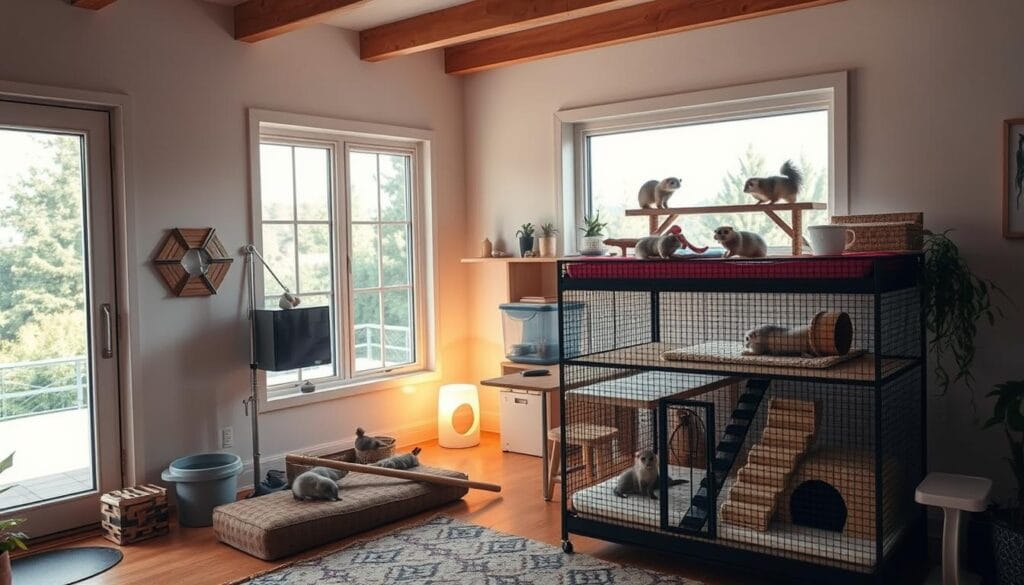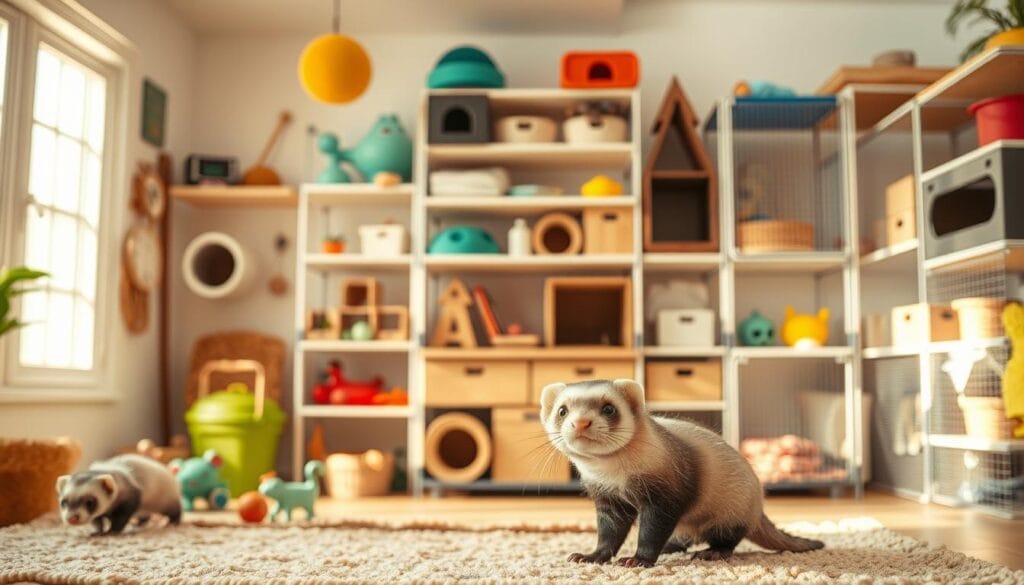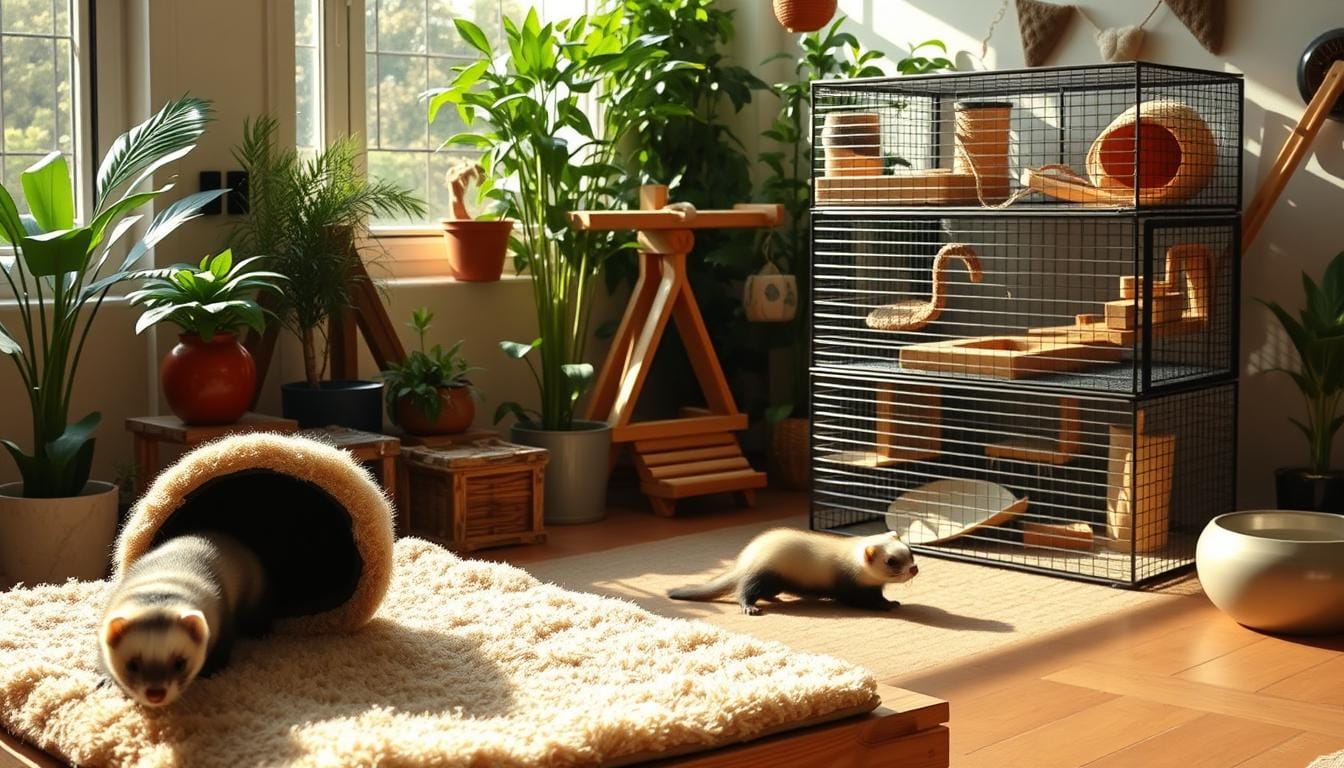Welcoming a ferret into your home means getting a playful friend with endless curiosity. They may be small, but they pack a lot of energy. A good ferret habitat setup is key to their happiness and health.
Imagine your ferret racing through tunnels or snuggling in a cozy spot. This guide will show you how to create that perfect home for them.
Setting up a ferret home begins with the basics. You’ll need a wire enclosure that’s at least 24x24x36 inches. Make sure the bars are no more than 1 inch apart to keep them safe. If you’re interested in exotic pets, like fennec foxes (like this fennec guide), you’ll see how different ferret care is. They have special needs, from food to playtime.
Table of Contents
Understanding Ferret Needs
Every ferret housing tips guide starts with their core requirements. To ensure optimal ferret living space, you must prioritize their social, physical, and mental needs. These playful animals thrive in environments that mimic their wild instincts while keeping them safe.
Socialization and Interaction
Ferrets are highly social and require daily interaction. Keeping them in pairs or small groups reduces stress, but always introduce new ferrets gradually. Handling your ferret daily strengthens bonds and aids in health checks. When free-roaming, supervise them closely—they explore every nook and may escape through tiny gaps like shower drains.
Space Requirements
Adequate space is vital for their active lifestyle. A single ferret needs a cage at least 24″ x 24″ x 36″ to move freely. For multiple ferrets, double the space. Outside the cage, provide 2-6 square meters of ferret-proofed room for exploration. Multi-level cages with platforms and tunnels mimic their natural habitats. Avoid overcrowding to prevent territorial disputes.
Enrichment Activities
Enrichment combats boredom and keeps them mentally stimulated. Include these essentials:
- Tunnels and hideouts for instinctive burrowing.
- Rotating toys like balls and chewables.
- Playtime during dawn/dusk hours when they’re most active.
Avoid leaving them alone in unsafe areas—they’re curious and can chew wires or ingest toxins.
Choosing the Right Cage
When picking a ferret cage, focus on safety and comfort. The best cage should have enough space, good airflow, and be sturdy. Ferrets need a place to climb, nap, and play safely. Here are some key points to think about:
Size Considerations
Begin with a cage that’s at least 24” wide, 24” deep, and 18” tall for one ferret. Add 12” of length for each extra ferret. Since ferrets sleep a lot, they need enough room to stretch and rest.
Bigger cages help reduce stress and encourage natural behavior.
Cage Types: Multi-Level vs. Single-Level
Multi-level cages let ferrets climb, but make sure the ramps are strong. Single-level cages offer more space for running. Your choice depends on your home and your ferret’s energy level. Here are some tips:
- Multi-level: Make sure the surfaces are non-slip for safety.
- Single-level: Add shelves or tunnels for fun vertical exploration.
Materials and Construction
Choose wire cages with solid floors. Wire floors can hurt a ferret’s paws, so they’re not good. The bars should be no more than 1 inch apart to keep your ferret from escaping. Use secure latches and materials that won’t get chewed, like powder-coated metal.
Avoid glass or plastic cages because they can trap heat and moisture.
Pro tip: Look for cages with easy-to-clean trays. Stainless steel bowls and non-toxic coatings are also good because they resist damage from chewing.
Invest in a cage that will last and grow with your ferret. A well-made cage keeps your ferret healthy and saves you money in the long run.
Essential Habitat Accessories
When setting up a ferret habitat, picking the right top ferret habitat accessories is key. These items help your pet stay healthy and active. They support their natural behaviors like burrowing, resting, and exploring.
Bedding Options
Paper-based bedding, like CareFresh, is safe and easy to digest. Use 1–2 inches to soak up moisture. Stay away from cedar or pine shavings because they can irritate lungs.
Clean bedding every week and daily spots to stop ammonia buildup.
- Choose paper-based products for respiratory safety.
- Replace bedding weekly and spot-clean daily.
- Avoid any bedding with added fragrances or chemicals.
Litter Box Setup
Put litter boxes in cage corners for easy reach. Use paper-based or pelleted litter, like FerretLabs, which are safe. Never use clay or silica litters because they can be harmful if swallowed.
Scoop litter twice a day and change it weekly.
Hiding Spots and Tunnels
Ferrets need safe places to hide. Choose hard plastic tunnels or fabric hammocks that are easy to clean. Make sure there’s at least one hideout per ferret.
Use boxes with smooth edges to avoid injuries. Switch tunnels every week to keep them interesting.
Optimal Cage Location

Choosing the right cage location is key for your ferret’s well-being. It keeps them safe and comfy. Make sure they don’t live outside to avoid harsh weather and predators.
Indoor vs. Outdoor Considerations
Keeping your ferret indoors is best for their health. Here’s why:
| Factor | Indoor | Outdoor |
|---|---|---|
| Temperature Control | Stable | Risky Fluctuations |
| Predator Risk | Low | High |
| Social Interaction | High | Low |
Put the cage in a quiet room, away from sunlight and vents. Don’t set up outdoor cages.
Temperature and Humidity Factors
Ferrets prefer temperatures between 60°F and 75°F. Humidity should be under 50%. Here’s how to keep it right:
- Keep the cage away from windows and heating/AC vents
- Use a thermometer and hygrometer to monitor conditions
- Avoid drafts and direct sunlight to prevent overheating
Watch for signs of overheating like panting or being very tired. Move them to a cooler spot right away.
Safety from Other Pets
Here’s how to keep your ferret safe from other pets:
- Elevate the cage so dogs can’t reach it
- Secure latches to prevent escapes
- Supervise interactions with other pets
Put the cage in a central but quiet spot. This balances social time with safety. Stay away from busy areas to lower stress.
Promoting Playtime and Exploration
Keeping your ferret healthy and happy is more than just a good ferret habitat setup. They need daily playtime for their body and mind. Ferrets should get 3-4 hours a day to play and exercise. This helps reduce stress and stops them from getting into trouble.
A 2019 study by Washington State University showed that just 10 minutes of playtime can lower stress hormones. So, playtime is good for both you and your pet.
Ferret-Proofing Your Home
Before letting your ferret explore, make sure their space is safe:
- Seal gaps under furniture or in floors (ferrets can squeeze through spaces as small as 1 inch)
- Wrap electrical cords with protective sleeves
- Remove small items like coins or buttons that can be swallowed
- Block access to toxic plants like lilies or azaleas
Creating a Play Area
Here are some ideas for a safe play zone:
- Set up a “dig box” with shredded paper or special ferret-safe sand
- Arrange tunnels and cardboard boxes for obstacle courses
- Include soft bedding areas for naps between play sessions
Safe Toys to Include
Choose toys that encourage natural behaviors:
- Soft rubber balls (no small parts)
- Plastic tunnels and chew-safe toys
- Avoid toys with string, small pieces, or rubber (can cause intestinal blockages)
Change toys every week to keep things interesting. Always watch your ferret during playtime to keep them safe.
Dietary Considerations
A well-planned diet is key for a ferret environment essentials. Ferrets need high-protein, low-carb meals. Their feeding areas must be safe and easy to access. This includes secure stations that prevent spills and encourage healthy eating.
Feeding Stations Setup
Start with heavy ceramic bowls or clip-on dishes to stop tipping. Keep them away from litter areas to avoid contamination. Puzzle feeders can make meals more fun and mentally stimulating.
Store kibble in airtight containers to keep it fresh and reduce waste.
- Use weighted dishes or wall-mounted feeders
- Place 2 feet away from sleeping zones
- Rotate puzzle feeders designs weekly for enrichment
Recommended Foods
Choose foods with 30–40% animal protein. This includes high-quality ferret kibble or meat-based kitten food. Avoid grains, fruits, or sugary treats.
Ferrets need 5–7% of their body weight in food daily, split into two feedings. Always avoid chocolate, caffeine, or alcohol, as they are lethal.
Hydration Needs
Ensure fresh water is always available. Clip-on bottles reduce spill risk, but shallow dishes work if secured. Clean containers daily to prevent bacterial growth.
Ferrets drink more when bowls are placed near their active zones, not near litter areas.
Maintaining these feeding practices aligns with their natural foraging instincts. It keeps their habitat clean and safe. Proper setup supports their 10–12-year lifespan potential with proper care.
Regular Cleaning and Maintenance
Keeping your ferret’s home clean is crucial for their health. A clean space keeps them safe and healthy. Here’s how to keep their area fresh and fun for them.
- Spot-clean bedding daily. Remove waste and uneaten food right away to stop odors.
- Weekly deep cleans: Change all bedding and clean the cage with safe cleaners. Use a 3% bleach solution for tough spots, then rinse well.
- Monthly deep sanitization: Take the cage apart, soak parts in bleach, and let them dry before putting it back together.
Safe Cleaners for Ferret Spaces
Look for cleaners without ammonia, bleach, or citrus. Good options include:
- White vinegar mixed with water (1:1)
- Pet-safe cleaners like Nature’s Miracle or Arm & Hammer Odor Absorber
- Stay away from scented sprays; they can bother their breathing
Health Benefits of Cleanliness
Cleaning often stops bacteria and lowers the chance of sickness. Ferrets’ musk is normal, but bad smells mean they might be neglected. Try to:
| Task | Frequency | Why It Matters |
|---|---|---|
| Litter box cleaning | Twice daily | Reduces ammonia buildup |
| Water bowl sanitation | Every morning | Prevents algae and bacteria |
| Toy disinfection | Weekly | Blocks disease spread |
“A clean habitat isn’t just tidy—it’s a lifeline for your ferret’s immune system.”
Follow this routine to keep your ferret’s space safe and welcoming. Small daily actions lead to a healthier home.
Health and Safety Precautions

Keeping your ferret safe is key. A safe place to live stops injuries and sickness. Regular checks help avoid dangers like getting stuck, eating harmful things, and getting too hot.
Identifying Risks in the Habitat
Look over your ferret’s home every day. Watch out for:
- Cage bars wider than 1 inch allow escape or limb trapping
- Plastic toys or bedding may be chewed and cause blockages
- Unsecured shelves over 12 inches tall risk falls
| Risk | Solution |
|---|---|
| Hot/Cold Spots | Keep habitat between 60-75°F |
| Wire flooring | Replace with solid surfaces to prevent foot injury |
| Electrical wires | Secure cords with cord covers |
First Aid Kit Essentials
Have these ready:
- Styptic powder for bleeding nails
- Electrolyte solution for dehydration
- Small digital thermometer
- Emergency vet contacts
Regular Vet Check-Ups
Don’t skip annual vet visits. Ferrets over 5 need visits every six months. Make sure they get shots for rabies and distemper. Talk to your vet about:
- Adrenal disease signs: hair loss, lethargy
- Insulinoma symptoms: seizures, weakness
- Dental checks every 6 months
Good care and vet visits can make your ferret live up to 6-8 years. A safe home and early vet care help avoid health problems.
Understanding Ferret Behavior
Watching your ferret helps you make a great home for them. They show happiness with a dook sound and stress with hisses. They love to play and show excitement with fun movements.
Look for signs your ferret needs a change. If they scratch too much or seem tired, they might be bored. Give them tunnels and toys to keep them busy.
Make sure they get enough time outside their cage. They need at least two hours of play each day. If they avoid the litter box, it might be dirty or in the wrong place.
- Common Behaviors: Hiding items is natural. Offer secure hide spots to satisfy this instinct.
- Distress Signs: Repetitive pacing or aggressive nipping can signal overcrowding or lack of stimulation.
- Positive Habits: A well-designed space with vertical climbing structures and digging boxes reduces unwanted behaviors.
Help your ferret develop good habits by matching their needs to your home. They sleep a lot, so make sure they have cozy spots. Change their toys often to keep them interested. A good home lets them tunnel, explore, and rest happily.
Building a Loving Environment
Creating a ferret habitat is more than just setting up a space. It’s about building trust and connection. Ferrets love to interact, so their home should encourage bonding. Place their cage where they can watch family activities to make them feel part of the group.
Design play areas with tunnels or obstacle courses. These invite you to play with them, strengthening your bond. Such moments are key to building trust and a strong relationship.
Bonding Activities
Make daily playtime a part of their routine. Use toys like balls or treat puzzles to play together. Ferrets sleep a lot, but they need mental stimulation during their waking hours.
Set up areas where you can easily interact with them. This helps keep the connection strong. It’s important to spend time with them, even when they’re sleeping a lot.
Meeting Emotional Needs
A safe environment reduces stress. Give them hiding spots and quiet areas, which are crucial for shy ferrets. Regular cage cleaning and a stable routine help them feel secure.
Ferrets live a long time, so their habitat needs to change as they grow or their habits change. If they seem stressed, like hiding too much, it’s time to adjust their space.
Recognizing Individual Personalities
No two ferrets are the same. Some love to climb, others to burrow. Watch how they behave and adjust their habitat to suit them.
For example, a curious ferret might enjoy more tunnels. A nervous one might need more hiding spots. Training them, like teaching them to use a litter box, shows their preferences and helps shape their space.
Your ferret’s habitat grows with them. By focusing on safety, emotional connection, and individual care, you create a happy home. Regular checks and changes ensure their space remains safe and joyful as they age.

